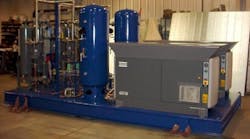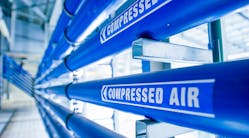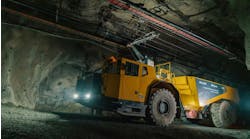A compressed air system is one of the most misunderstood of all industrial utilities. Even the best engineering courses have little more than a few hours of education regarding air. If you have trouble getting the correct information from salesmen, your only source of information must be experience.
As a result, here are some things that regularly occur in industrial settings:
• If there is a complaint about low pressure in the production area, another compressor is turned on. If that doesn’t help, another is turned on. If maintenance runs out of compressors, they buy more until the pressure rises enough to keep production people from complaining.
• If production people complain about contamination and the compressor appears to be working based on supplier service inspection, maintenance will replace the equipment with more of the same or deem it inappropriate and buy different clean-up equipment.
• If problems persist on a piece of equipment, maintenance will change service companies and never buy that brand or type of equipment again.
What should be painfully obvious is that none of these decisions had anything to do with business sense, systems jeopardies, or any problem definition. Keep in mind that many shop mechanics make their operational and maintenance decisions based on the following commandments:
• keep it running,
• control the maintenance cost,
• anticipate and prevent failure, and
• keep the telephone from ringing.
Real-world Example #1
At one of our plants (I was working for a different company then), we had a chance to reconfigure the air system to adapt to an improved manufacturing process. Until then, the role of utilities was so submissive to production that manufacturing didn’t even see the point of a briefing. I asked what the rules were for the use of compressed air at the point of use. A production manager clarified things quickly. He said, “We take it...you make it! If you do a good job, we can keep the costs down.” That seems pretty clear, doesn’t it?
Everyone wanted to discuss what new supply-side equipment should be put into the budget. I thought it made more sense to figure out what we needed. History had shown that no matter how much air was available, we quickly needed all of it. Instead of discussing how many compressors, what brand, type, and size, I got them to agree that demand should drive the supply. The spokesman for production told us they were going to need about 4000 cfm more than what they had now. I asked how they determined the 4000 cfm, and at what pressure they needed it?
The pressure they requested was 90 psig — higher than any previous accepted minimum pressure. Utilities had taken their numbers and inflated them by a 20% “fudge factor” on volume and 5% on pressure. When done, we had arrived at 4800 cfm at 115 psig.
The preliminary guess at compressor and auxiliary requirements put this expansion at around 1250 bhp. Correcting the fudge factor put it closer to 800 bhp. This was 322 kW less and at $0.08 per kW per hour, meant $25.81 less per hour just for electricity or $266,074 per year difference in operating cost. The reduction in capital was more than $76,000 including installation.
We next refined the loading and determined that we had sized the units too large. Their sizes were based on the peak of 4800 cfm and convenient to sizes available from vendors. We also realized that the base load changed dramatically, not only within any shift, but from shift to shift. With this information, we realized that we only had enough blow off capability. This led us to look at two different compressors.
We therefore increased the number of compressors and substantially reduced their size. Although we didn’t realize it, we had also reduced the risk of interruptions because of there were less consequences of a unit failure. Our capital requirements were reduced further, as well as the annual operating cost. We were entering the reconfiguration process with a $302,074 reduction in first-year capital and operating cost just by reducing the fudge factor.
Next, I asked what was the minimum acceptable air pressure in production and if it was needed. Production said they needed 90 psig, but it would be nice if they had more. I asked how much more. They said 100 psig. Why? They said more would be “nice.” This would have required 2008 hp to elevate the pressure 15 psig for the entire system above the current lowest pressure of 85 psig. Doing this would cost $1.14 million. I asked what they would get for the elevated pressure. The spokesman said, “I don’t know...probably feel a little better about the reliability of the air system, but I didn’t consider how much that would cost.” You can buy a lot of psychiatric couch time to improve your feelings for $1.3 million!
Real-world Example #2
A second example involved an automotive assembly plant that had 73,000 scfm, but more than 19,000 cfm of leaks. This plant was a 24-hr, 7-day operation; they never shut down unless they absolutely had to. Under these circumstances, no one had noticed how much air was being serviced in the system in shut-down mode. This was based on the number of compressors they had to run to maintain pressure when they did nothing. Everyone agreed that there were many leaks.
No one knew how much the leaks amounted to or what was the energy required to support them. One person mentioned they had tried to get management to support a leak-fixing exercise. But management didn’t want to spend an unspecified amount of money for an unmeasurable result.
We determined the volume of what we could not shut off and subtracted it from total supply at our lowest load. That was 19,000 scfm at full line pressure — air that was being used with the plant shut down! (I’ve seen hundreds of plants with this percentage and a few plants with more leaks by volume). We used more than 4800 bhp of compression equipment to maintain the extraordinary waste. That’s more than $318 per hour, or $2.79 million per year.
Three concepts to remember
Several years later, I had the opportunity to work in the field for a major pneumatic tool-and-hoist manufacturer, which provided the next steps in my thinking process. During nine weeks of training, we were taught how to optimize air tools as they were applied to industrial applications. Three major ideas came from this.
One was that equipment efficiency was a function of how it was installed. Whenever we demonstrated or tried a tool for a user, we always tried to use our own company-supplied hose and fittings. There was no explanation or technology supplied, other than the fact that the tool would work better. It would achieve more torque, grind more metal, etc. We found that most manufacturers did not go out of their way to specifically state required volumes or pressures required for proper operation.
The second idea was that you could get applications to work more efficiently at the same pressure or get the same efficiency with more volume at less pressure. As the volume of air required by the tool was a function of the supply pressure, the higher the supply pressure, the more scfm exhausted. You can achieve the same amount of work energy by increasing the mass inversely proportionate to the reduction of the absolute pressure.
The third idea was that sometimes, because of compressed air supply limitations, a different style of tool or size of air motor is necessary.
What if we treated our electric systems the same way we treat compressed air?1. We would have to remove all the nameplates from the motors and electrical devices. We normally have no idea what volume or pressure is required of air using devices other than by trial and error. 2. We would buy electrical-using equipment with no regard to voltage, amperage, or the effect that it might have on the system, assuming that the local utility would compensate for whatever the results were on the system. 3. We would remove all the circuit breakers, transformers, capacitors, and starters from the system and use only primary power, regardless of need. If a particular user required control, we would put rheostats on those applications and nothing on the balance of applications. 4. We would use one or two sizes of wire and connection components on all electrical applications, regardless of voltage or amperage, and expect maintenance and the local utility to correct the system to compensate for how the production works. The size and selection of those components would be determined by the stores department and purchased based on price, availability, and minimizing inventory. Example: Use 1⁄4-in. hose and fittings on all applications regardless of flow or pressure. Once the connections are made, if the application doesn’t work, you simply increase the pressure supplied to the equipment until it works the way we want it to. Wouldn’t that be interesting to do with electricity? 5. Give every operator and supervisor the phone number of the local utility. If the equipment in production isn’t working the way that they want it to — regardless of any changes in speeds, feeds, faults, or any other problem — they simply call the local utility, who will alter the way they are supplying electricity to the plant to correct that single problem. If they cannot correct the problem with more whatever, they will simply buy more whatever or build another power plant and try again to solve the problem which was reported over the telephone. After all . . . electricity is free! Well . . . certainly compressed air is free . . . isn’t it? Some of you may think that this example is ridiculous. Actually it would be a relatively close parallel to the way that most compressed air systems are operated. The sad part of this is that there are limited resources available to learn more about compressed air. |
This article is based on Compressed Air System Solution Series, a book by R. Scot Foss, president, Plant Air Technology, Charlotte, N.C.


